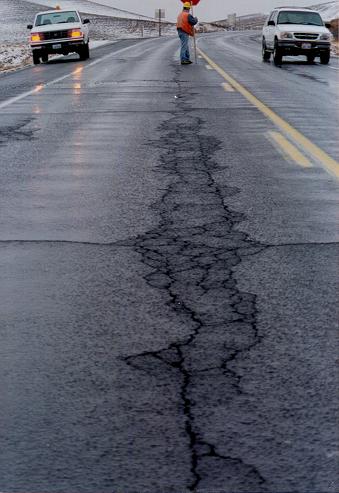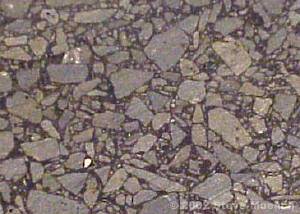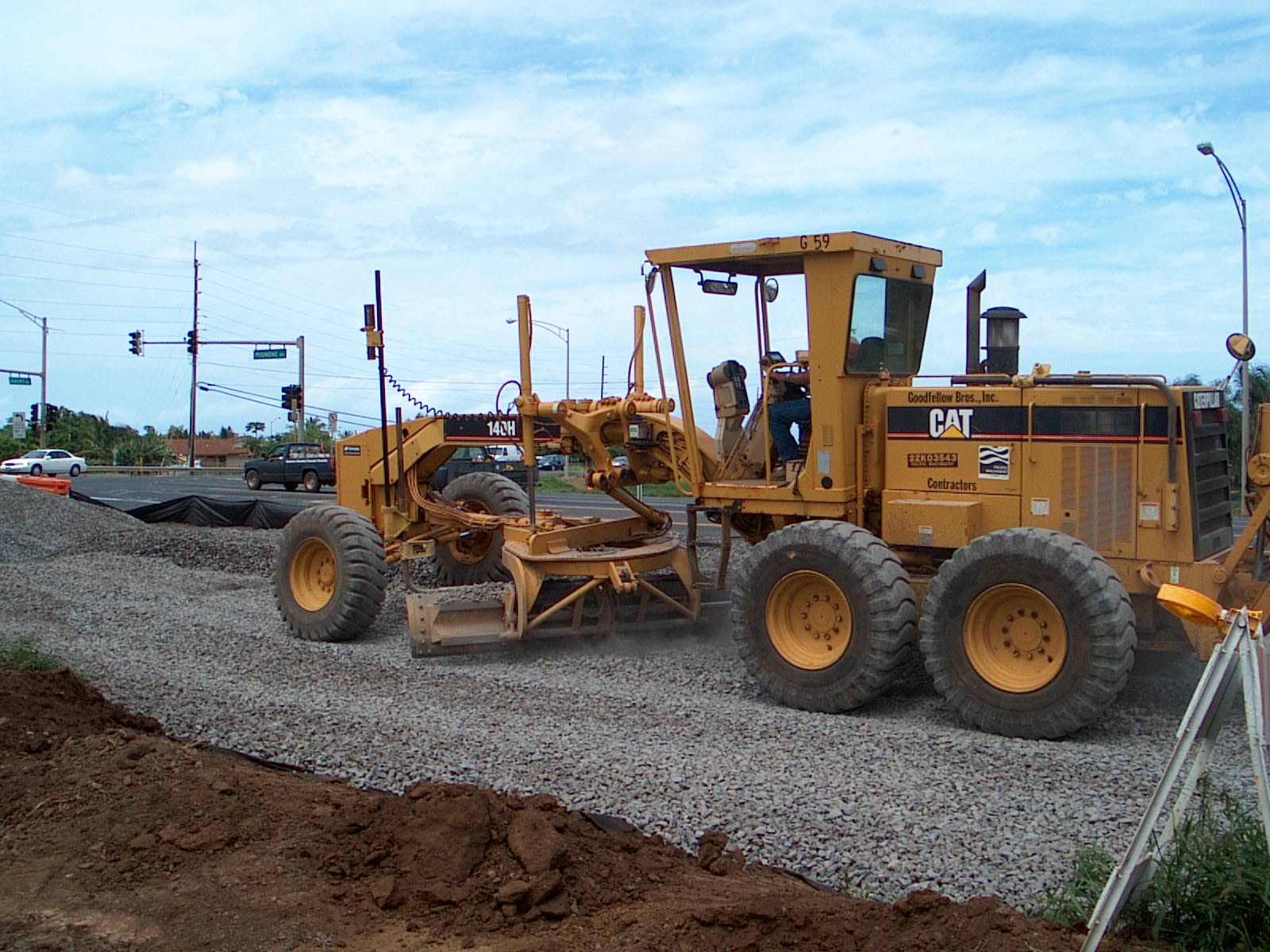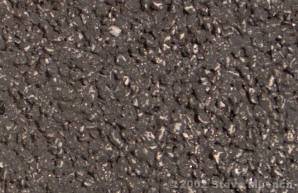Water is sometimes called the “universal solvent” because given enough time, it will dissolve just about anything. Even something that appears pretty permanent, like an asphalt pavement, can be eroded and damaged by water action. Roads are still exposed to the elements, however, and it would be virtually impossible to keep a pavement from coming in contact with water. This means that road design needs to take into account how we can minimize the damaging effects of water on the pavement structure. In this edition of the RoadReady newsletter, we’ll look at strategies for preventing moisture damage in asphalt pavements.
In conjunction with traffic loads, moisture can be a contributing factor in many pavement distresses, including cracking, raveling, rutting, and stripping. Water can get into the pavement structure in various ways and may either be flowing (precipitation such as rain or snow) or stationary (groundwater, which can be absorbed into the pavement structure by capillary action). Be aware of these potential sources of water on your project – some of their effects may vary, but all moisture will attack the bond between asphalt binder and aggregates in the pavement. As a result, it is important to design and build pavements in a way that minimizes their moisture susceptibility.

Mix Design
Pavements should be constructed based on a mix design capable of handling environmental conditions they will encounter, including exposure to water. Both the materials used to produce the mix and the gradation selected should be appropriate for the circumstances.
Materials
The resistance of a pavement to stripping and moisture damage depends on a combination of material characteristics. In the case of asphalt binder, higher viscosity is generally better because it indicates greater adhesion and makes it harder for water to interfere with bonding. However, individual chemical components of the asphalt, such as carboxylic acids and sulfoxides, can be easily displaced by water and affect moisture sensitivity.
Depending on their structure and composition, aggregates can also affect how vulnerable the pavement is to moisture damage. The size and extent of pores in the aggregate surface may cause water absorption, as well as increasing the amount of binder required. The chemical composition of the aggregate affects whether it is more or less likely to bond with any water that may be present.
Regardless of other characteristics, aggregates used in an asphalt mix should be clean and dry. Dirty aggregate will interfere with the adhesion of the asphalt binder, and clay contained in the aggregate may lead to stripping. Wet aggregate can trap moisture in the mix as well as weaken individual aggregate particles.
Gradation
The gradation of an asphalt mix has a significant impact on how the pavement deals with moisture. A dense-graded mix should be relatively impermeable to water if it is compacted to a sufficient density. Gap-graded mixes such as stone matrix asphalt also typically have low permeability and can be used for improved rut resistance. An open-graded mix, meanwhile, is actually designed to be permeable to water. This can have benefits by reducing splash and spray in wet conditions, but requires a pavement design that will ensure proper drainage.

Additives
A variety of additives can be incorporated into a pavement to improve its resistance to moisture damage. Liquid anti-stripping agents include latex polymers along with amines and polyamines (chemical compounds that will tend to bond with water and keep it from disrupting the binder-aggregate bond). Hydrated lime is also commonly used for this purpose. Polymer-modified binders can be selected as part of the mix design. The impact of additives depends on the combination of ingredients in the mix, so this should be tested when determining the job mix formula for the project.
Pavement Structure
The structural design of the pavement needs to be capable of dealing with moisture properly. That generally means keeping water from entering the pavement structure and ensuring any moisture that does enter is drained away. This depends on achieving the correct density and slope during pavement construction and providing features such as gutters or ditches for drainage. For subsurface drainage, permeable base layers and pipe collection systems may also be used.

One important consideration with respect to pavement structure is selecting appropriate maintenance and rehabilitation treatments as they are needed. If a treatment fails to take into account the design and condition of the existing pavement layers, it may actually trap water in the structure and accelerate moisture damage.
For example, an open-graded surface course is designed to allow water to penetrate that layer as part of the pavement drainage system. Covering this with an asphalt overlay can effectively seal water underneath the surface of the pavement and lead to serious problems. A similar issue has been observed in which chip seal treatments have sometimes caused stripping in the underlying asphalt pavement. This is typically a problem when the pavement has low density and high air voids, so moisture gets in and the structure underneath the chip seal is not sufficiently dry.

Good Design Can Handle Moisture
Rain is usually tough on drivers, and it can be tough on roads as well. Pavements may be designed to deal with moisture in various ways, but it takes a combination of elements to successfully address the problem. By following best practices to prevent moisture damage, we can keep pavements in better condition and improve their service life.
Additional Links
Oregon Department of Transportation, Evaluation of Latex Polymers to Resist Stripping in Asphalt Pavements in Oregon: http://www.oregon.gov/ODOT/TD/TP_RES/docs/Reports/EvalOfLatexPolymer.pdf
Minnesota Department of Transportation, Stripping of Hot-Mix Asphalt Pavements under Chip Seals: http://www.dot.state.mn.us/research/TS/2013/201308.pdf


Bside to the previous study we have to pay attention to the following points;-
1- the qulity of bitumin qulity must be improved by improving viscosity,either by chemical reagent,and or by incresing mixing temp.to elemenate volatiles and other acidic fractions (the evaporated fractions my be used as energy source for drier)
2- tO IMPROVE COATING @STRIPPING result by using 100%cruched aggregates
3- WE have to pay attention to the vechle tire pressure, may be we can reduse the surface wearing.
4- surfac maintannce now is the effective factor.
with my respect.
mahmoud youns
EGYPT CAIRO
The article has been excellent providing insight to many problems. The ‘moisture effect’, has been a perpetual problem for the roads in the North Eastern part of India- Assam and all the adjacent states, where rainfall are very heavy and continues almost through the summer. Crossfalls (Cambers) alongwith the drainage layers underneath the WBM layers though help sometimes, we are yet to find a sound way to reduce ‘moisture effect’.
We suffer from the same problem in ٍSome rainy places of Egypt. I hope to eliminate it from Egypt&India soon.
It’s really a knowledge enhancing paper on making a good and lasting pavement. But as
it has mentioned at the begening, it’s just impossible to keep water away from pavement, some quality solution on repair of such damaged pavements should be very helping to every one.
Thanks
Really it is agood information paper
Because we can not keep the pavement from moisture, a good drainage system is very necessary by using filter layers underneath the base to eliminate ground water capillarity action,also by a good drainage systems and paved shoulders to drain the surface water to shed the surface flowing water to eliminate penetration of water,and finally using additives to the bituminous wearing course especially anti-striping agents.
After 36 years in the paving business in Canada, I can attest to the serious pavement damage done by water. It seeps into pavement structures through cracks and permeability and comes up from wet aggregate bases. I have seen 200 mm pavements almost completely stripped of asphalt, from water from below the pavement, due to poor drainage. We have tried every method to reduce or eliminate water damage and found that “timely” road maintenance (resurfacing, crack sealing and pothole repair), along with appropriate construction and drainage designs, work best if incorporated into a single plan free as possible from political interference. If you have water damage you likely have frost damage as well in Canada. Good article.
It has been experienced at many instances that fear of rutting (due to excessive bitumen content) espally in hot weather results in design of mixes with less bitumen and porus which gives way to rain water resulting in premature failure.